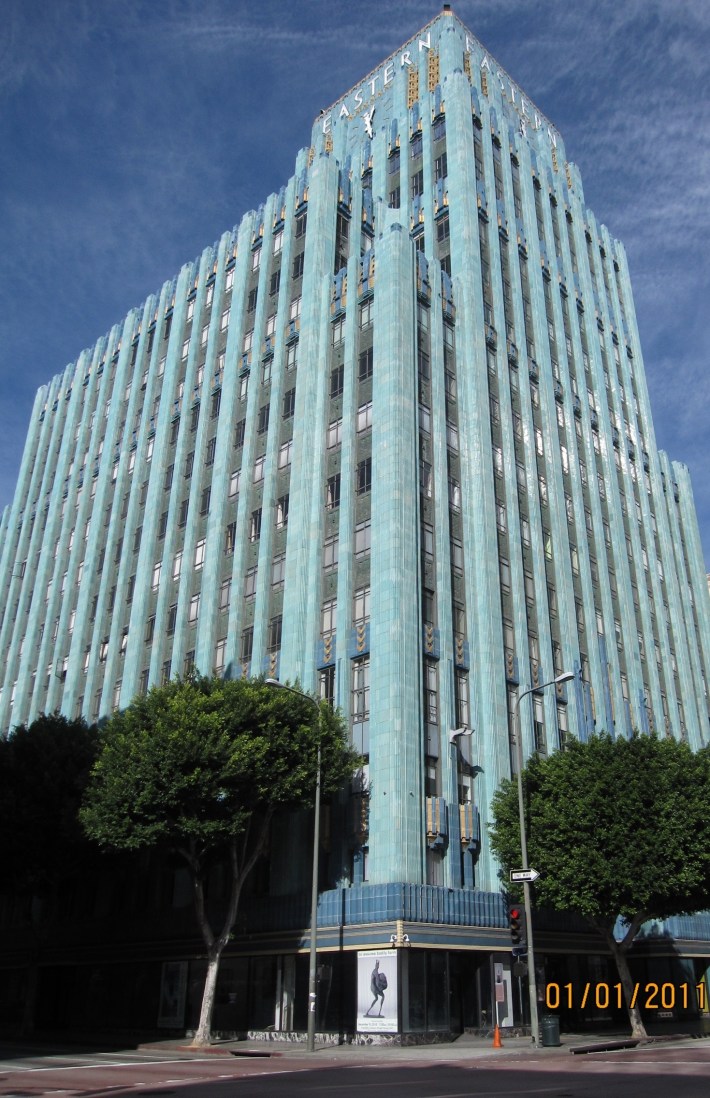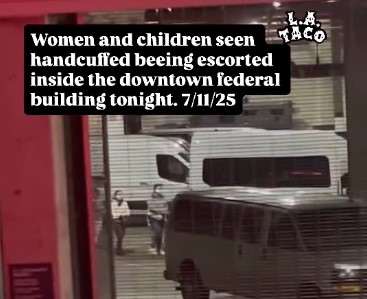
Donald Shoup is one of my heroes. He’s the authority on parking: how it shapes cities, how it enables driving, and how cities can fix the problems that parking policies create. He has a legion of followers who proudly call themselves Shoupistas. Shoup is retiring from UCLA this year. The college is sending him off with a fundraiser retirement dinner atop parking structure number 32 on Saturday May 30. You can attend, and hobnob with Shoup himself, by donating to the Shoup Fellowship fund for future UCLA planning students.
Below is part one of my interview with Don Shoup. The interview took place at the UCLA Faculty Center on Friday, May 15, the day after UCLA’s Complete Streets Forum, where Professor Shoup had been impressed with a presentation on the soon-to-be phased out traffic congestion metric, Level of Service.
Joe Linton: For many years, as a cyclist and bicycle activist, I didn’t really think about parking. I thought “I don’t park – it’s not my issue.” But then Beth Steckler, my boss at Livable Places, recommended that I read The High Cost of Free Parking. I did, and it really opened my eyes. It’s one of the few books that has really changed the way I look at cities.
Don Shoup: I think that most people are not interested in parking itself. So I’ve tried to convince them that parking is important for what really interests them, which may be affordable housing or climate change or traffic congestion or fuel consumption or accidents or health or whatever.
And I think that’s why people are beginning to pay attention to parking – because they can see it’s perhaps the easiest way to make improvements in what they’re concerned about.
Whatever the concern, I think the most politically feasible and most cost-effective way to advance the cause is often to fix parking.
I don’t expect many people to be interested in parking per se. Most academics have neglected parking because it has such a low status.
In universities, no matter how much we talk about justice and equality, there are strict status hierarchies. International affairs are the most overarching topic. And then national affairs are very important. State government seems provincial. Local government is totally parochial. And then in local government, what’s the lowest status thing you could talk about? That would be parking.
So I’ve been a bottom feeder, but found a lot of food down there.
And there’s so much to see if you just look at it very carefully. I think if you look at anything carefully you will find that it’s fascinating.
I am happy to think that you and others are seeing the connection between parking what you’re now interested in– the Level of Service metric for traffic congestion
Most of us are not interested in measuring the Level of Service at intersections. Nevertheless, at the Complete Streets forum yesterday, Chris Ganson, from the California Office of Planning and Research, explained why inappropriate LOS measures prevent infill development and why theyinstead encourage suburban low-density development.
Linton: I call it zombie engineering. Though it’s not just engineering, it’s also planning, design. There are so many practices and policies and rules that say we have to do the car stuff first and foremost, that they end up with a life of their own. You can get rid of Level of Service, and the next thing is going to be financing or something else. It just feels like a multi-tentacled monster — cut one off, and there are still a hundred more rules saying you have to accommodate car stuff first.
Shoup: Yes, that’s true. So long as the tentacles don’t regenerate, it is worth cutting them off.
I think part of the problem with zombie urban planning is that many people, including me, don’t have a strong visual understanding of the effects of something like Level of Service measures or parking requirements.
I was in Vancouver a couple weeks ago. I hadn’t been there for forty years. It was fascinating to see it looking a bit like Hong Kong, except …well, far better-looking. There are a lot of new high rises downtown – condos, apartment buildings, and office buildings. They have very wide sidewalks and not that much traffic congestion and [on] almost every block there will be a high rise. And you like it without knowing exactly why.
I spoke at UBC, and one of the city officials said, “we require off-street parking in downtown to be underground.” So as you walk along you don’t see any parking structures. You don’t see any parking lots. In fact, you don’t even see the entrances to the underground garages because they’re in alleys.
So you have this strange juxtaposition of high density and not being overrun by cars.
To think that it could have been one sentence, “all off-street parking for new buildings must be underground,” and you would have no idea – most people wouldn’t until it actually happened – how that would utterly change the look of the city.
The old areas don’t have any parking because they were built before cars. In the ’50s and ’60s there were parking garages of the sort we’re used to here in L.A., but they would never be allowed again.
And the old parking garages are prime sites for redevelopment at high density because there’s no displacement. No tenants to relocate.
Parking lots and parking garages have turned out to be – in New York and in other places – the go-to place for redevelopment, because they offer a big area and they don’t have any tenants.
It’s hard to redevelop an apartment building in Los Angeles because you have to relocate all the tenants. There will be lawsuits. There will be required compensation. There will be political fights about gentrification.
You can’t say that about a garage. You can’t say that about a parking lot.
I think that’s why – in cities that don’t have off-street parking requirements like New York and Seattle – parking lots and small parking garages are just asking to be redeveloped, if the land values are high.
In Downtown L.A. you can’t do it. It’s very hard to redevelop a parking lot or a parking garage because the first thing the city planner is going to say: “where’s the required parking?”
The parking lots are often small so you can’t get a good building and the required parking on the same site. So the small surface lots that pockmark the city are pretty much frozen in place until we remove the parking requirements.
But when we get rid of the parking requirements there’ll be great dollar signs for development on every parking lot.
The proof of the redevelopment potential is what happened as a result of Los Angeles’ Adaptive Reuse Ordinance.
Spring Street, Main Street, and Broadway have the largest collection of intact office buildings from the early 20th century in the country, maybe the world. They were great buildings in terrible condition because urban renewal on Bunker Hill sucked all the life out of Spring Street, which used to be called the Wall Street of the West. These great financial buildings lost their office tenants and couldn’t find any other tenants. Most of them were empty above the ground floor for decades. Some of them were used for sweatshops.
Then, in 1999, the City Council passed the Adaptive Reuse Ordinance, allowing conversion of historic office buildings into housing with no new parking. That is the key thing: no new parking. You had to keep whatever parking a building had, but that was sometimes none at all.
Critics said, “it’ll be a disaster” and “no lender would lend to convert an office building into housing” and “no one would want to buy an apartment in a converted building without parking” and “no bank would give you a mortgage on an apartment without parking” and “no developer would be interested in this.”
Why that would be a disaster I don’t know. It just means nothing happens. Anyway, there was a lot of criticism.

One of the historic downtown L.A. office buildings converted to housing under the Adaptive Reuse Ordinance. Photo by Don Shoup
In the next eight years, 57 of these historic buildings were converted to housing. Something like seven thousand new units.
Just think of all the plumbers and electricians and architects and drywallers and all kinds of people who got employed in the conversion. And all the new housing.
At a debate, I made this point about the 57 buildings and I just tossed in the fact that it led to the historic preservation of a lot of beautiful buildings. A guy behind me said that it also led to the preservation of an entire historic district. It turns out the guy behind me was the head of the L.A. Department of City Planning. I thought, well, why didn’t I say that first?
I think that the ARO – aside from leading to great historic preservation, a lot of employment, and a lot of great housing – also revealed what the parking requirements were preventing. You normally can’t see what doesn’t happen. What wasn’t happening was the restoration of great office buildings and a lot of new housing.
I think many of the small parking lots in downtown aren’t developed for the same reason that these historic office buildings hadn’t been converted to housing – because of the parking requirements.
Most of the downtowns that people want to visit – like in San Francisco, New York, Vancouver, Seattle or Chicago – don’t have any off-street parking requirements. If L.A. follows these cities, our downtown will begin to look less like Phoenix, Houston, or Detroit, which do require off-street parking in their downtowns.
Downtown L.A. has more parking spaces per square mile than any other city on earth, yet many people think it’s not enough. But if we, or when we, remove the off-street parking requirements downtown, I think you’ll see a building boom that will make the current one look small.
There’s so much land that’s surface parking. Just look from Google Earth. I’ve used Google Earth to compare downtown L.A. and downtown San Francisco; there’s nothing similar between them.
We have a few icons with gigantic parking garages. Disney Hall has six levels of underground parking; you take the escalator cascade into the lobby and never set foot on a sidewalk.
The equivalent hall in San Francisco, Louise Davies Hall, has no parking. After a concert people swarm out onto the sidewalk. Bars are open. Flower shops are open. Bookstores are open. And you have to walk to your car if you drove.
Every new building in L.A., like Disney Hall or the Broad Museum – whose parking structure cost $80,000 a space, paid for by the city – must have its own parking. L.A. zoning would not allow the Broad Museum without any parking. I think that San Francisco would have no problem with a new museum downtown without a single parking space.
Linton: I am curious to hear about what first got you interested in parking.
Shoup: I was an electrical engineer as an undergraduate. Then, I got interested in economics, so got a Ph.D. in economics. While I was doing that, I got interested in the land market. I wrote my dissertation on the urban land market. Since parking is the single biggest land use, with more footprint than housing or offices or schools or anything else, I think that may have interested me.
But the first thing that really got me interested in parking was a request from the California Transportation Commission to write an essay on equity in transportation.
For some reason, I had read a paper written in 1969 by two USC graduate students who were interns to a parking consultant Rex Link. Link thought it was unfair that a government agency would give free parking to automobile commuters, but nothing to its employees who don’t drive to work. The two students, for their capstone project for an M.A., compared commuting patterns at two office buildings at the L.A. Civic Center, which is the largest center of government in the U.S. outside Washington, D.C.
They surveyed the staff at a county office building and a federal office building next door. The county offered free parking to commuters who drove to work, and nothing to anybody else. The federal government did not subsidize any commuting.
These two buildings had the same kind of employees and the same location. The students interviewed employees and found that 40 percent of the federal employees drove to work alone, and 72 percent of the county employees drove to work alone. Just because of the employer-paid parking subsidy.
I thought, “that’s unfair!” The county is giving free parking to drivers and nothing to everybody else. Employer-paid parking is also inefficient because it worked against things the county says it’s trying to reduce: air pollution, traffic congestion, and fuel consumption.
It was the inequity – the injustice of employer-paid parking – that got me started on parking research. Then it just kept rolling. That’s a long answer to your question. But my first research on parking was about was the unfairness of a policy that most people think of as generous.
Similarly, most people think that the Level of Service metric for traffic congestion is a good idea: the goal is to avoid congestion in a neighborhood. Most people think, “Who could object to an employer providing free parking? What kind of scrooge would object to that?”
That’s what led me to propose parking cash-out. It’s now a state law, but the state has done a poor job of implementing it. Most employers have never heard about parking cash-out.
About the only time you hear about parking cash-out being adopted, it’s when one of my former students who bikes to work at a firm tells the Human Resources staff “A state law requires employers who subsidize parking at work to offer the cash equivalent of the subsidy to commuters who don’t drive to work.” HR takes a look at the law and a month later a letter comes out, “we decided to offer a very generous new fringe benefit for employees who don’t drive to work.”
But for some reason the South Coast Air Quality Management District and the Bay Area Air Quality Management District have been very unwilling to even publicize the law.
The legislature, just four years ago, added a new feature to the law saying that any air district and any city can pass a penalty for violating parking cash-out law. But they haven’t done it yet.
Linton: So how long have you been teaching at UCLA?
Shoup: I came to UCLA in 1968 as a post-doc. Then I taught at Michigan from ‘70 to ‘74. I came back into UCLA Urban Planning in ‘74. I’ve been in this department for 41 years.
Linton: What has that been like? What has changed in your tenure at UCLA?
Shoup: When I started in ‘74, the Urban Planning Department was famous for being the farthest left department in the country, and because of that we attracted a lot of great students. But there was an infatuation with Mao – we even had wall posters like the ones in Beijing. There was a moratorium in my first year when all classes were canceled so we could rethink the curriculum to get rid of cut-throat competition among students for grades, as though there was any such thing.
I thought it was a madhouse.
I was teaching economics to these students and I realized you can’t teach urban planners economics the way you teach it to business students. So I had to repackage what I was teaching – and began to focus on the economics of collective action, public goods, the free rider problem, externalities, equity, and other things the students wanted to learn about.
Every time I would bring up an idea like charging for parking to reduce traffic congestion and air pollution, many students responded: that’s not fair because it will hurt poor people who can’t afford to pay for parking. This made me aware that you have to anticipate these objections and you should adjust your proposals to meet them in advance.
For example, parking cash-out does not charge anyone for parking. Instead employers who offer a parking subsidy to drivers must offer the same subsidy in cash to bicyclists, pedestrians, and bus riders. So it seems a lot fairer than offering free parking or nothing. Parking cash-out treats everybody equally.
I’ve tried to package an idea so that people will see that it is fair, that it benefits them individually, and that it’s also good for society. I have learned to present ideas so that planners, elected officials, and Streetsblog readers might think “that’s a good idea.”
There was a slow learning process. A very slow change in me but also in the students who are no longer coming in waving red flags and wanting to be guerrillas in the bureaucracy. They want a fairer world, but they also want a job.
During the political uproar in planning in 1975, I probably would have been considered the faculty member least likely to have a book translated into Russian, to have several articles translated into Chinese, and have an appointment as a professor in Beijing. But that’s what happened.
And it isn’t so much that my ideas have changed. I think the world has also changed.
Look for part two of the interview next week.






